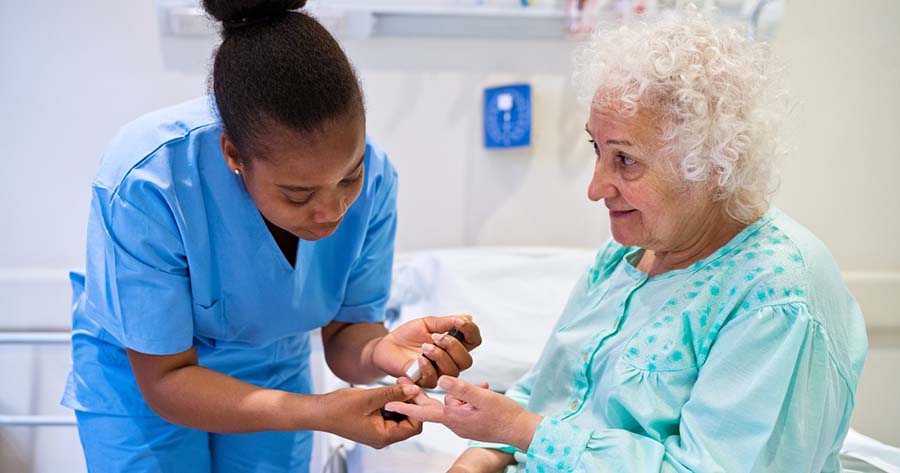The global population is ageing and health issues are becoming more complex as we move through the decades. Concerns over financial constraints of services, increasing health inequalities and rising public demand are ongoing. Ultimately, the desired outcomes continue to be advancement in provision of high-quality care, uncomplicated access to services and greater involvement of new technologies in healthcare (Department of Health, 2006; NHS, 2019).
Unfortunately, since the COVID-19 pandemic, care has been further impacted, with unprecedented demand for healthcare services resulting in deteriorating mental health, a rise in emergency care attendances and long waiting times, leading to significant concerns regarding the safety of care delivery (Ham, 2020). Healthcare professionals are expected to respond to this, particularly by advancing their practice. In the current climate, advanced clinical practitioners are considered important for service transformation and to effectively meet healthcare needs (NHS, 2019).
Benefits of evolving nursing
Nurses have always been on the frontline of healthcare provision and have seen to the needs of the population for 200 years (World Health Organization [WHO], 2020). Nurses currently account for a large proportion of the NHS workforce, although staff shortages, retention and career progression remain problematic (NHS, 2019). The roles and responsibilities of a nurse are constantly adapting to new ways of delivering healthcare. Today, the roles and responsibilities of a nurse at initial registration level include some responsibilities that were previously associated with medical roles (Dalton, 2013; Barton et al, 2015; Nursing and Midwifery Council [NMC], 2021). The NMC (2018) created new standards of proficiency for the education of student nurses in preparation for registration in line with the changes in society and healthcare, labelled the “Future nurse”. Some clinical skills required in the new standards, such as the interpretation of chest X-rays, would previously only have been formally taught in post-registration education.
Historically, the first growth of advanced nursing was the role of the specialist nurse, noted in the US and later internationally recognised in the 1960s, with the Advanced Nurse Practitioner (ANP) role becoming more compelling in the 1970s (Barton et al, 2015; Cooper et al, 2019). The ANP role is a popular avenue for nurses to pursue following initial registration and an encouraged route to take, with many countries reporting to have advanced practice roles for nurses (WHO, 2020). Advanced nursing practice is viewed as a more general area of practice (Cox et al, 2012; Cooper et al, 2019). The definitions of the ANP and nurse specialist roles vary, with neither having statutory regulation or protected titles in the UK (Leary et al, 2017).
Some literature suggests that one of the main reasons for nurses beginning to expand their roles was due to a reduction in junior doctor hours (McGee and Castledine, 2003; Dalton, 2013); however, a more positive view would be to see advanced nurses as a filled gap between nurses and doctors, resulting in better collaboration (Andregård and Jangland, 2015).
The role of the Diabetes Specialist Nurse (DSN) was also introduced around the 1960s to assist doctors with case workload and provide diabetes patient education to improve care management. Following the introduction of DSN roles, care delivery standards for clinicians in diabetes were produced (Brooks, 2005; Valentine et al, 2003; James et al, 2009). Unlike ANPs, DSNs focus on all aspects of diabetes care but can still be employed in primary, community or secondary care.
In response to changing demands, DSNs have had to further specialise in structured education programmes, advancing technologies and non-medical prescribing in recent years (TREND-UK, 2015); thus, there is evidently a continual need and expectation to expand their specialised nursing role.
Both ANPs and DSNs are seen as inspiring clinical leaders who improve team working; provide evidence-based, holistic patient care with reduced waiting times; and achieve cost-effective organisational goals. They can establish more personal and tangible patient relationships and patients feel that they listen to and appreciate their worries and concerns more than medical staff (Dalton, 2013; Andregård and Jangland, 2015; Woo et al, 2017). Nurses report that ANPs are more approachable than doctors for support and decision making (Andregård and Jangland, 2015).
Barton and Allan (2015) noted that the impact of ANPs still requires a greater evidence base as there is little research regarding outcomes. However, the effectiveness of DSNs is regularly assessed and reviewed in national and local audits and initiatives. For hospital inpatient DSNs, reduced length of stay and admission avoidance is the most common metric used to assess DSN effectiveness and value (Lawler, 2020). Inpatient DSNs are also associated with reductions in medication errors and inpatient diabetes emergencies, and improvements in healthcare education and patient knowledge of safe self-management (McHoy, 2003; Akiboye et al, 2021).
Unclear definitions
The Department of Health (2006) published the report Modernising nursing careers – setting the direction, which highlighted nurses taking on new role elements and working at higher levels to improve patient care. Although not specifically titled, the document similarly describes an ANP. In contrast, clinical nurse specialists such as DSNs, who share role similarities and effectiveness with ANPs, are not always described as being in advanced clinical practice positions (Cooper et al, 2019).
Health Education England (HEE, 2017) and the International Council of Nurses (ICN, 2020) state that ANPs should be registered practitioners who have acquired the expert knowledge base, complex decision-making skills and clinical competencies for advanced nursing practice. They should also hold area-specific clinical competencies encompassing characteristics of leadership and management, and research and education. The ICN states that this should be underpinned by a Master’s degree or equivalent. HEE does not specify an area of qualification and there is no single recognised qualification for DSNs (TREND-UK, 2015).
The Department of Health and Social Care (2010) published a position statement to be used as a benchmark to promote good employment practices and consistency in nurse title use, including those of relevant healthcare professions. There are various definitions of the ANP and nurse specialist roles, with neither having statutory regulation or protected titles (Leary et al, 2017). The Royal College of Nursing (RCN, 2018) recognises there are multiple roles developing at advanced practice levels, including ANPs, Advanced Clinical Practitioners and Nurse Consultants.
The term “advanced-level practice” has been applied to a number of different nursing roles, often leading to confusion about the scope and competence required at an advanced level. The RCN, HEE and Department of Health do not propose type or speciality of practice to be an indicator of advanced-level practice (Cox et al, 2012; Cooper et al, 2019; Hicks and James, 2020).
The NMC (2018) has defined a list of ANP activities to underpin the role. These included comprehensive history taking, diagnosis and treatment of health needs, and referral to appropriate services. This also reflects the position of the RCN (Cox et al, 2012; RCN, 2018). Unfortunately, these skills do not transfer to other allied healthcare professionals, such as midwives, making them feel excluded (Cox et al, 2012). The RCN (2018) feels employer-led governance, in conjunction with the NMC Code, should monitor advanced practice roles, similarly to the Council for Health Regulatory Excellence (Cox et al, 2012).
In the UK, there is confusion over job titles and responsibilities. Leary et al (2017) identified 595 different titles in specialist nurse positions, of which Clinical Nurse Specialist and ANP were among the most common. Definition and regulation of job titles, including the title “nurse”, has been a topic of discussion for a number of years. Although there are some protected healthcare titles in the UK, such as “paramedic” and “operating department practitioner”, the nursing profession continues to struggle with gaining protection.
Employers have added an excessive number of nurse titles with varying skills, resulting in misunderstanding of role meanings and the competencies of practitioners, both for clinicians and for the public (Cox et al, 2012). This conflicts with RCN (2018) recommendations and does not provide assurance to the public that nurses in advanced roles are complying with their fitness to practice in a planned and purposeful manner, underpinned by measurable and safe education.
The NHS Agenda for Change framework has contributed to the role confusion by designating Band 7 positions as “Advanced Practitioners” and Band 8 as “Consultant Practitioners”, with no clear evidence to define this (Barton and Allan, 2015). As TREND-UK (2015) also discussed, the Agenda for Change states that “senior nurses” in diabetes should be aligned to the advanced nurse profile and are expected to have or be working towards a Master’s degree. However, in the TREND-UK competency framework, these would be referred to as a “senior practitioner” or “expert nurse”.
A lack of regulation for these positions increases the probability that nurses who have not been adequately educated or competency-assessed could impact patient safety. Although discussed, there has been no progress in regulation due to changes in government and senior NMC leadership, along with the financial implications of regulation (Barton and Allan, 2015).
Regulation, protection and clear definition of role titles would provide assurance to the public of a professional’s appropriate education to a standard of quality, provide professional identity and potentially improve healthcare provision (Leary, 2011; Leary et al, 2017). It would also provide commissioners with more accurate staff figures to make decisions about future service development plans and appropriate expenditure (Hicks and James, 2020).
Competencies: Added confusion?
In order to provide some definition to advanced nursing practice in England, HEE (2017) created a competency framework alongside a definition statement to further enable consistent understanding of the role, although there is no distinct recommendation for a Master’s-level award or equivalent. The competency framework is divided in to four pillars of practice: Clinical practice; Leadership and management; Education; and Research.
The RCN (2018) states that ANPs are educated at a Master’s level in clinical practice with competent, expert knowledge and skills in autonomous decision making in assessment, diagnosis and treatment of patients. However, it expanded its support to registered nurses working at an advanced level of practice and stated that, by 2020, they would have education and training at Master’s level and have significant roles within the four pillars, very similar to HEE (2017).
The competency framework for DSNs (TREND-UK, 2015) is outlined differently. It is not solely for the use of DSN roles and branches out to other nursing roles supporting patients with diabetes, such as practice nurses. The framework is used for professional development and for commissioners to identify staff suitable for delivery of services, with each competency statement outlining a standard of diabetes care delivery and a competency level assessed against these. No role title is assigned to a competency level; rather, nurses are categorised from unregistered practitioner to consultant nurse.
In a survey of the DSN workforce, 243 respondents provided 25 different role titles, the most common being DSN (Lawler et al, 2020). It is not uncommon for Practice Nurses to refer to themselves as “Diabetes Nurse” despite the possibility that they do not possess the required specialist skills (Hicks and James, 2020).
Each of the frameworks strongly encourage their use to be principles and to be utilised in conjunction with good governance and workforce integration.
What inhibits DSNs and ANPs from developing their roles?
Barriers to achieving competencies usually include time constraints, high workload, organisational structures and varying support levels. Research has low output for both ANP and nurse specialist roles (Cooper et al, 2019). DSNs experience a lack of time and resources to dedicate towards continuing professional development and research, limited study time and declined funding requests, despite the growing number of new and complex treatments that are available (James et al, 2009). The TREND-UK (2015) competency framework requires research participation for the consultant nurse level. James et al (2009) feel the lack of commitment to support DSNs in research will further inhibit successful integration into advanced practice in the future.
Demand on DSN teams in order to reduce hospital length of stay and patient harm is increasing; however, this is in the absence of an increase in the number of DSN positions or a change in pay, in an effort to achieve a financial saving opportunity of £2.5 billion. This has notably increased DSN workload, caused inadequate staffing and reduced available time for professional development (NHS Digital, 2020; Lawler et al, 2020; Rayman and Kar, 2020).
There is an increased need for appropriate courses which ensure that ANPs have adequate educational preparation and support with a more standardised approach, which would build confidence (Stasa et al, 2014; Cooper et al, 2019). DSNs have also noted a need for structured advanced-level education for credibility and expertise (Fenn, 1998).
Some considerations
From the areas discussed, it seems unlikely there will be many changes to role clarity for ANPs or DSNs in the near future. Given continued financial restrictions, further exacerbated by the COVID-19 pandemic, it would seem unlikely for any costly recommendations such as regulation or increased funding to be achieved.
More sensibly, commissioners and employers adopting a better and more uniform governance approach to titles, role definitions and responsibilities, in line with the workforce needs and using governing frameworks, could improve job satisfaction, security, recognition and value. Reviewing current positions, removing any conflicting roles, utilising workforce time and encouraging research and development may improve achievement of competencies.
Advanced clinical practice has constantly evolved over the years to keep up with increased service demands, to maintain health and wellbeing outcomes, and to tackle workforce safety issues. Interest in advanced clinical roles could become even greater given the challenges healthcare is facing in the aftermath of the pandemic.
It is inevitable that nurses will continue to expand and develop in the role, even from training, as seen in the updated standards of proficiency for the education of student nurses, whereby newly qualified registered nurses will have received education on what are now considered postgraduate skills. Currently, registered nurses would need to be a number of years post-registration before being considered for courses in the area.
In addition, the emergence of new roles with no protected title, registration or regulation will make it more difficult to predict the expansion and monitoring of these advanced practice positions at local and national levels, potentially hindering their support and encouragement to apply, as well as decreasing patient safety. Currently, as there is no standard, clear education pathway, course or framework for either role, varying knowledge and skill levels are apparent. Pay scales and role titles are not necessarily determined based on knowledge and skills, nor are they even consistent in all areas across healthcare. Nurses working toward ANP or DSN positions will likely be able to demonstrate their higher level of learning; however, if education requirements and courses were structured and comparable, it would enable more confident, satisfied and supported advanced practitioners. ANPs and DSNs are already demonstrating the effectiveness of their roles, seeing significant improvements in patient satisfaction, reduced waiting times and hospital length of stay or avoidance. All of these outcomes correspond with current healthcare recommendations.






Key scientific developments presented at the conference.
6 Aug 2025